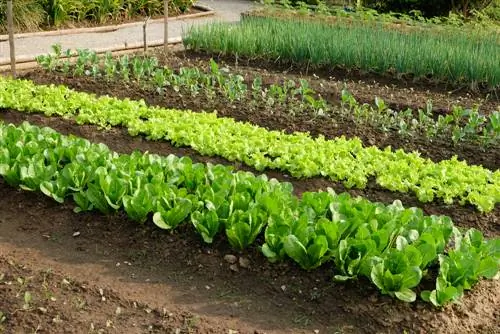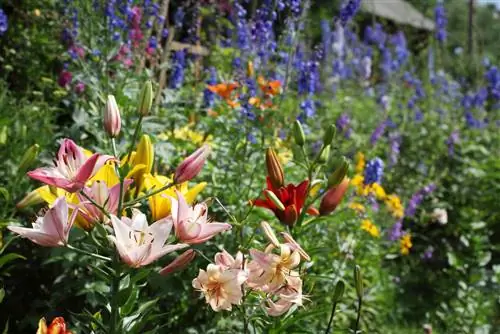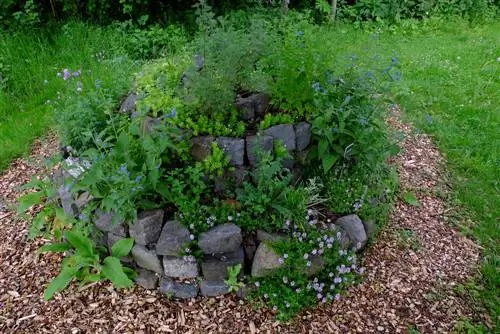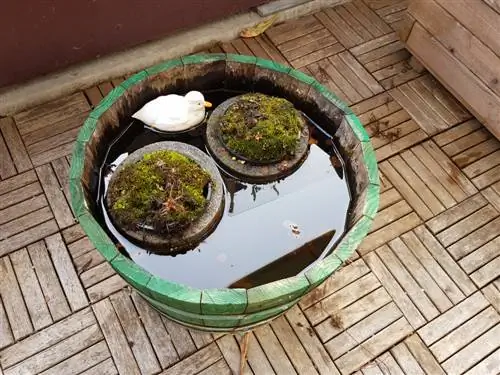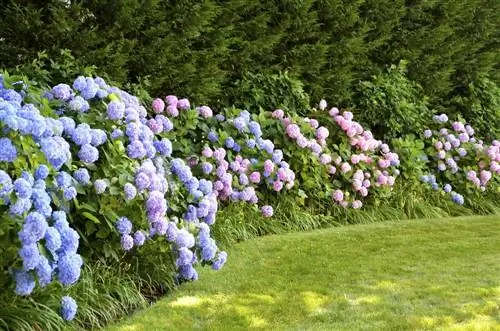- Author admin [email protected].
- Public 2023-12-16 16:46.
- Last modified 2025-06-01 06:02.
Many people dream of a large self-sufficient garden, especially given all the food scandals in recent years, pesticides in fruit and vegetables, etc. Don't just dream, just do it - we'll show you the best way to do it hire.

How do I plan a self-sufficient garden?
The vegetable garden should be at least 100 square meters per person. There is also space for fruit trees and bushes. A kitchen garden needs a location in full sun and loose, humus-rich soil. Also think about supplies for the winter and seeds for the following year.
- In order to provide yourself almost entirely with fruit and vegetables, the garden should be at least 100 square meters in size - per person eating. There is also space for fruit trees and bushes.
- A kitchen garden needs a location in full sun and loose, humus-rich soil. The humus content can be increased with compost, rotting manure and green manure.
- Good planning is essential throughout the entire gardening year: bringing forward plants, sowing and planting, mixed and subsequent crops, harvesting and making supplies, collecting seeds for the next year, garden and tree care, etc.
- Always grow more vegetables and fruit than you use - after all, as a self-sufficient person, you have to stock up for the winter.
Plan a self-sufficient garden
But before you run into the garden and create beds there, sit down at the kitchen table with a piece of paper and a pen. Good planning is the be-all and end-all for a self-sufficient garden so that you actually grow and harvest the fruit and vegetables you want in the right (i.e. required) quantities. In addition, there should be no idle times in which beds remain empty - when they could still be planted instead. In addition to the quantity, planting planning is also important in which you determine sensible mixed and subsequent crops and thus ensure optimal use of the area.
How big should the garden area be for self-catering?

If you want to feed yourself entirely from your own garden, you need at least 100 square meters of space per person
The most important question at the beginning is: How big does the garden area have to be so that you can feed yourself and your family with it? There are different answers to this, depending on what exactly you want to do and how much time you have.
| Self-sufficiency level | Size of garden area |
|---|---|
| almost entirely from our own garden | at least 100 square meters per person, plus areas for fruit trees and bushes |
| mostly from our own garden | approx. 75 square meters per person, plus area for fruit trees |
| partly from our own garden | approx. 50 square meters per person, plus area for fruit trees |
| only certain types of vegetables and fruits | as much area as is needed to grow the desired vegetables and fruits (can also just be the balcony) |
So if you don't want to buy any or only very little fruit and vegetables, the garden for a family of four should be 400 square meters - plus the growing areas for fruit trees and bushes. While the shrubs can be easily planted along fences, trees need a lot of space.
A large apple tree alone needs an area of around 50 square meters - half-trunk or columnar shapes of course less. An apple half-trunk needs around 25 to 30 square meters of space. Sweet cherries and walnut trees, on the other hand, are real space hogs, as both types can grow very large and wide and require a corresponding amount of space. The following table gives you an overview of the space required by the different types of fruit:
| Type of fruit | Space requirement in square meters |
|---|---|
| Apple, standard stem | 50 to 60 |
| Apple, half trunk | 25 to 40 |
| Pear, standard stem | 50 |
| Pear, half trunk | 20 to 40 |
| Blackberry | 6 to 10 (depending on growth habit) |
| Hazelnut | 20 to 50 (depending on variety and growth habit) |
| Raspberry | 6 to 10 (depending on growth habit) |
| currant | 6 to 10 (depending on growth habit) |
| Plum | 40 to 50 |
| Peach | 30 to 50 |
| Quince | 50 to 60 |
| Sour cherry | 40 to 50 |
| Gooseberry | 6 to 10 (depending on growth habit) |
| Sweet cherry | 80 to 100 |
| Walnut | 80 to 100 |
The space specifications may seem exaggerated at first glance, but they are actually rather limited. Remember that a fruit tree can become very tall and, above all, wide with age - then space is necessary. Also think carefully about whether you want to plant tall or low-stemmed trees; both have their advantages and disadvantages. While low-stemmed trees are easier to harvest and cut, tall ones are generally he althier and longer-lasting - even if you then need a ladder to harvest apples. If you plan to mow the meadow under the fruit trees regularly, we recommend using tall varieties - otherwise it will be difficult to mow, especially with a ride-on lawn mower.
Which vegetables are particularly productive?

Which types of fruit and vegetables you grow in your garden obviously depends primarily on your taste and that of your family. However, if you are self-sufficient, you should make sure that you also grow sufficient varieties that are suitable for cooking, drying and storing. To determine your needs, first write down for a few weeks what fruit and vegetables you buy in the supermarket every day and in what quantities - and then plan the area to be grown. Don't forget the winter months, because you have to plant or harvest the fruits you need in the summer.
It is also important to know that there are early, medium and late ripening types of most vegetables and fruits. The early varieties usually have a short shelf life and must be consumed or processed quickly. On the other hand, many late-ripening vegetables and fruits can be stored well; after harvesting, they should be kept cool and dark - for example in a storage cellar or rental area. Particularly important in the self-sufficiency garden are high-yielding varieties from which you can get a generous harvest.
Not to be missed:
- Fruit vegetables such as zucchini, pumpkin and cucumbers
- Tomatoes, peppers and chili - especially in the greenhouse!
- Root vegetables such as carrots, parsnips, horseradish, beetroot
- various types of cabbage (white and red cabbage, savoy cabbage, cauliflower, broccoli, kale etc.)
- Salads (pick lettuce, cut lettuce, Asian salads, lettuce, winter salads such as lamb's lettuce etc.)
- Legumes such as beans (bush beans, runner beans) and peas (sugar and split peas)
- Onions and garlic
- Potatoes
- if necessary, corn and other speci alties such as physalis, Jerusalem artichoke, tomatillo (depending on taste and personal preferences)
Important for self-catering: herbs and medicinal herbs from your own garden
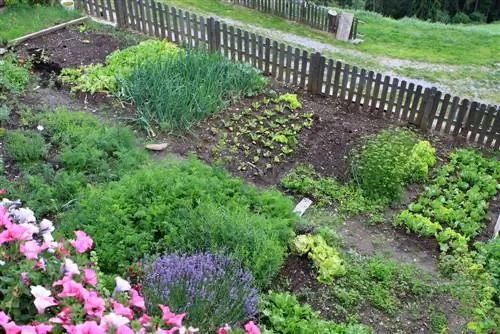
Herbs are tasty, he althy and keep pests away
Fresh herbs for seasoning in the kitchen and for medicinal purposes are also indispensable for self-sufficient people - for example, if you have a sore throat and a sage tea should help. You can grow these in a separate herb bed - the individual species nicely sorted according to your preferences in terms of location and soil - or in mixed culture in the vegetable bed. Some herbs are also very suitable for bordering beds, as their strong scent keeps many pests away. Varieties such as lavender, sage and basil are particularly suitable for this purpose.
Excursus
How much time do you have to plan for gardening?
What you shouldn't forget when planning a self-sufficient garden: A garden like this takes a lot of work all year round! On average, you should plan around half an hour to an hour of work per day for a garden of around 500 square meters, although the amount of time will of course also depend on what needs to be done. For everyday tasks such as watering, hoeing and weeding, you can do just fine with this information.
However, when it comes to work such as creating beds, planting and sowing, harvesting and preserving, you can spend whole days busy. Even in winter there are still activities left, for example because you can start preparing the plants for the new season, pruning fruit trees, etc. from January onwards.are busy. It is therefore important to continuously work in the garden.
Create a self-sufficient garden
Now that you have determined the garden space you need and the vegetables you want to grow, you can now get to work. But first, a tip: If you are new to gardening, you should not start with a large area right away - even if it is tempting. Start small, perhaps with just one bed at first. Gain experience and gradually enlarge your garden year after year: then you are more likely to actually stick with it. However, if you start with a huge area (possibly with little experience in the garden), frustration will quickly arise and with it the risk of ending the project over it.
The optimal location and the right garden soil
So that the plants in your kitchen garden grow diligently and also taste good, they need sun - and as much of it as possible. Optimal growth is guaranteed if
- The beds should be as sunny and protected as possible
- the location is airy, but sheltered from the wind and warm
- the soil is loose and well-drained
- but can still store water (clay content!)
- and has a high humus content
Of course not everyone has garden soil like this. However, you can improve your specific conditions by adding mature compost and sowing green manure in the fall - primarily legumes, as these increase the nitrogen content in the soil. These measures are also necessary to preserve areas that are intensively used for gardening. These forms of natural fertilization improve soil life and thus increase the humus content in the soil.
Create beds and paths
Now you can create the beds and paths. The best way to do this is to make a plan by transferring the existing area to scale on a piece of paper and then drawing in the corresponding areas. The illustration shows you a suitable example of such planning:

Optimally:
- vegetable beds are no wider than 1.30 meters
- this makes them easier to edit because you can easily reach all places
- are they rectangular or square
- this also makes editing easier
- rammed paths paved with bark mulch etc. run between them
- small paths should be at least 60 centimeters wide
- Main paths at least one meter (so that you can easily get everywhere with the wheelbarrow)
Don't forget the greenhouse and the tool shed. Both should be located, if possible, close to the house, but not too far away from the kitchen garden and should be easy to reach with wide paths. Make sure that none of the buildings cast a shadow on the vegetable beds. The fruit trees should be the furthest away - ideally in a meadow orchard, which is also good for a variety of useful insects and birds.
Must be in every self-sufficient garden: the compost heap
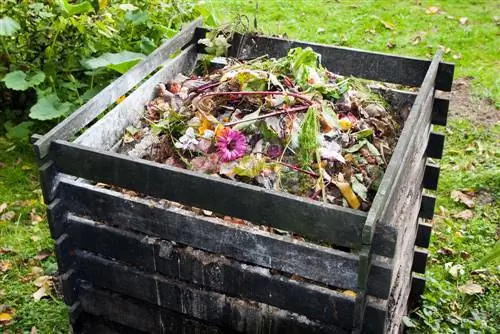
The compost heap is a must for every self-sufficient garden
The compost heap should also not be missing, because on the one hand, self-sufficiency creates a lot of garden and kitchen waste that should be disposed of as naturally as possible and, on the other hand, in this way you gain valuable ecological fertilizer for your garden. It is advisable not to just throw the waste into a heap, but to plan the composting sensibly:
- Choose a partially shaded location, preferably slightly hidden by bushes and trees.
- This should be as close as possible to the house and the flower beds.
- So you don't have to walk too far from the kitchen or the beds.
- Use several composters that you can build yourself out of wood, for example.
- This is how you can get different types of compost.
- Euro pallets are very suitable for this purpose.
- However, the soil should remain open so that the soil organisms that are important for humus formation get into the compost.
It is also important that the compost heap is easy to reach via a wide, well-paved path - and that you have enough space there to be able to use a shovel and wheelbarrow.
Excursus
What garden tools do you need in a self-sufficient garden?
The market for gardening tools is huge, no wonder that it's easy to lose track, especially as a newcomer. The following equipment is absolutely necessary: spade, digging fork, shovel, rake(s), rake, hoe(s), weed cutter, garden and pruning shears in various sizes, ax or hatchet, watering can, bucket (preferably plastic or enamel), Wheelbarrow(s) and a lawn mower (if there is lawn) or a scythe (if there are meadows). Last but not least, a ladder should not be missing. If there are tall fruit trees, a fruit picker is also quite practical, as it saves you having to constantly climb up and down the ladder.
The self-sufficient garden throughout the year
The first plants you should plant in your self-sufficient garden are fruit trees and bushes. This must be done as quickly as possible. These trees need a few years after planting until they bloom for the first time and you can harvest them. This section will show you how to plan for the rest of the gardening year.
Mixed culture prevents diseases and pest infestation

Onions protect strawberries from pests
In a self-sufficient garden, a well-thought-out mixed culture in the beds is recommended. This means that you do not plant each bed with just one type of vegetable, but rather combine plants that harmonize particularly well with each other. These fuel each other's growth and keep pests and pathogens away from each other. Such a mixed culture also offers the advantage that plant-specific diseases do not spread - unlike in monocultures, where the entire harvest is then at risk. But be careful: not all plant species get along with each other, which is why you have to plan such a planting carefully.
Smart crop rotation for high yields and a long growing season
Some vegetable plants have a very long cultivation time, others ripen more quickly and are therefore harvested more quickly. Here, too, clever planning ensures that after harvesting faster-maturing vegetables, the bed does not remain empty but continues to be used. It is therefore a good idea to start in spring with fast-growing varieties - such as radishes, spinach, lettuces, etc. - and then, after they have been harvested, to plant slower plants in the bed (especially those that only go outside from mid to late May anyway like zucchini and other cucurbits) and finally end the year with fast-growing vegetables or late winter varieties (beets and other root vegetables, late cabbage varieties, etc.). But the same applies here: not all types of vegetables harmonize with each other.
First aid against pests and plant diseases: healing from nature
“There are no chemicals in the self-sufficiency garden - everything you need comes from nature with absolutely no side effects!”
Self-sufficient gardening is primarily about independence. Of course, this also extends to fertilization, pest control and plant protection. You don't need any supposed chemical miracle cures for this, but you can rely entirely on the powers of nature:
- Compost, manure and autumn green seeds as ecological fertilizers
- naturally designed garden in which all kinds of useful animals feel comfortable
- many insects, birds, hedgehogs, shrews, lizards, frogs and toads help diligently with pest control
- Home-made plant manure made from nettle, tansy, field horsetail, etc. can be used very well against plant diseases
- Garlic and onion - for example as extracts - also help against diseases and pests
Also think about when you put which plants where - well-thought-out mixed and subsequent crops also help to keep the garden plants he althy and not provide any points of attack for pests. Balanced fertilization and irrigation do the rest.
Getting seeds and growing young plants
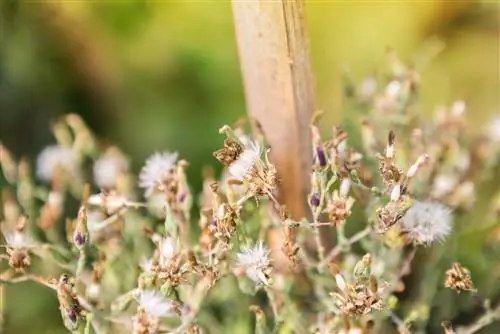
A few plants (here lettuce) should not be harvested so that they produce seeds
In the garden, the new growing season begins very early, because the first vegetable plants have to be grown in January, but at the latest in February and March. Especially many fruit vegetables that are only allowed in the bed in May due to their sensitivity, or varieties that have a long germination phase, should be sown early. There are different options for this, depending on the type of vegetable and the time of sowing:
- in the indoor greenhouse / on the windowsill in the house
- in the cold frame / under glass
- in the bed under foil
The best way to find out when you can sow which vegetables is to look at the seed packets for the selected varieties. Over time, you will finally know when seeds you have collected yourself will go into the bed. By the way: Not all vegetables are suitable for growing, some should be put in the bed straight away. These include many root vegetables such as carrots and radishes, but also fast-growing, insensitive vegetables such as spinach.
Tip
If you sow or prefer to sow vegetables, do not sow all the seeds at once. Instead, sow the planned carrots / radishes / kohlrabi etc. a little later so that not all vegetables are ready to harvest at the same time.
Harvesting and preserving
If you want to be self-sufficient, you have to stock up. That's why you should always grow enough fruit and vegetables so that you have enough quantities for the winter
- cooking: Vegetables and fruit that cannot be stored for too long
- drying: herbs, dried fruits and dried vegetables
- freezing: suitable for almost all vegetables, herbs and fruits, but very energy-consuming
- orstorage: many late vegetables and fruits such as potatoes, carrots, storage apples, pumpkins
can. Please note that you need a lot of space to store supplies effectively. A cool, dark and dry basement is best suited for this. Some vegetables can also be stored in soil piles, especially potatoes, cabbage and root vegetables. It's best to pay attention to the appropriate storage life when choosing a variety - not all types of potatoes or apples can be stored for a long time.
The self-catering garden in winter
This informative article shows what great tips self-catering Rigotti has for a winter harvest.

Frequently asked questions
What do self-catering people actually eat in winter?
Quite simple: What is still to be harvested in the garden or the supplies created during the summer. In this respect, it is important to plan well and grow enough vegetables and fruit so that you can still cook and freeze them. Some vegetables such as parsnips, Brussels sprouts etc. can still be harvested fresh in the winter months - as long as it is not too cold and you have planted/sown them in time. Good planning is everything in a self-sufficient garden! And whatever else is missing or doesn't grow in your own garden, you can still buy it in the supermarket.
Can I actually provide myself with vegetables from my balcony?
Of course, almost every vegetable can be grown on the balcony, so that with good planning and care you can also reap a rich harvest. In addition to the obligatory tomatoes and cucumbers, peppers, physalis, lettuces, radishes, sugar peas (short varieties!) and bush beans are particularly suitable for growing on the balcony. Zucchini also grow well here, provided the plant pot is large enough and you water them heavily several times a day if necessary. However, there is not enough space for complete self-sufficiency.
What do I do if the weather is bad and the harvest is in danger of failing?
Good planning also helps here to prevent crop failures due to a possibly rainy summer. Some vegetables should be grown in a greenhouse from the outset or, if grown outdoors, protected by a roof, for example. These include, for example, tomatoes, which tend to die outdoors due to late blight. But cucumbers and peppers also feel more comfortable in the greenhouse. Less sensitive plants such as the various types of cabbage are recommended for outdoor use.
However, outages due to bad weather cannot be completely avoided. Heavy rain and hail can still destroy entire harvests. However, even after such an event, you still have the opportunity to still be able to harvest by subsequently planting or sowing (fast-growing) vegetables.
Help, snails are eating my vegetables - what helps?
Venuous snails are every gardener's worst enemy, as they eat the entire garden bare in no time. However, it is not slug pellets that can help with this, but more sensible, non-toxic measures such as a snail fence around the beds, coarse mulching material on the beds and the targeted settlement and promotion of snail-eating creatures such as birds, hedgehogs, shrews and tiger snails. They continually keep the population of slugs small so that there is still enough lettuce and the like left for the harvest.
Tip
If you want to harvest potatoes in June, you should choose early varieties and plant them from February, but at the latest from March.

